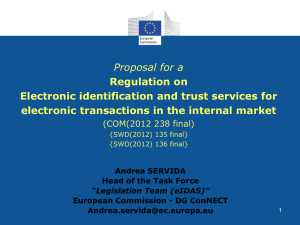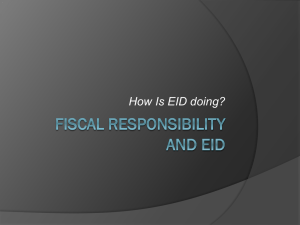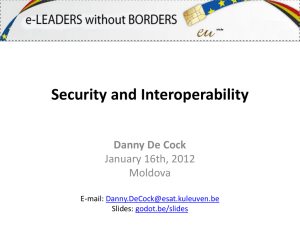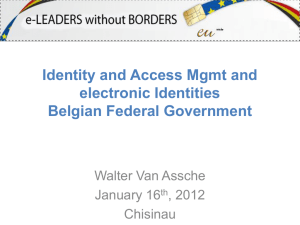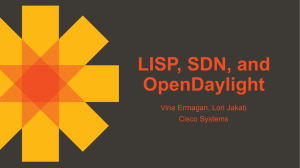3rd generation eID
advertisement
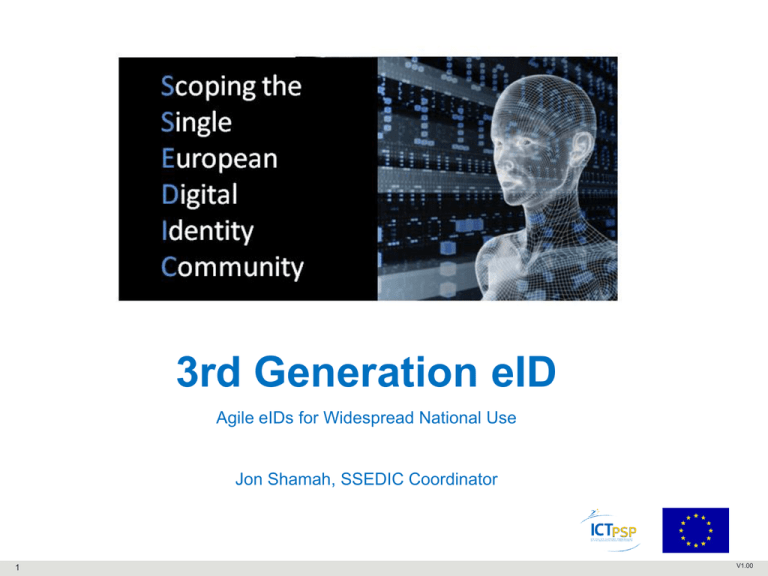
3rd Generation eID Agile eIDs for Widespread National Use Jon Shamah, SSEDIC Coordinator 1 V1.00 Agile eIDs for Widespread National Use • Introduction • 1st and 2nd Generation Architectures • 3rd Generation Architectures 2 Agile eIDs for Widespread National Use • Introduction • 1st and 2nd Generation Architectures • 3rd Generation Architectures 3 It is a National eID – not National Identity Card 4 Agile eIDs for Widespread National Use • Introduction • 1st and 2nd Generation Architectures • 3rd Generation Architectures 5 1st Generation eID • Government Owned • Embedded Chip – Contact/contactless interface – ICAO Applet – 2 or 3 digital certificates • Printed Data on surface – Facial Biometric – Name – Date of Birth • T1 form factor polymer card • On-line or off-line use 6 1st Generation eID Schemes • eGovernment access • ICAO Travel Document • Digital signing via contact interface with digital certificate (EU Qualified) • Authentication for private applications with limited liability Expensive to implement, slow to deploy, and heavy on support 7 1st Generation eID Architecture 8 2nd Generation eID • On-line use only • Mainly Bank or Private Sector owned • PKI stored centrally • Released by a On-Time Password device • Multiple authentication methods with ‘platformless’ option • Example: 9 2nd Generation eID Schemes • No travel document • Cannot be used for ad-hoc digital signing • Server form and on-line digital signing • Uses existing registration processes via banks, telco operators and local government • Simple to use • Fast deployment • Low-support costs Low cost to implement, fast to deploy, and light to support, but no off-line capability and cannot be used as an ID card 10 2nd Generation eID Architecture Private Sector provides Identity Assurance User is logged in Central server stores keys One Time Password authenticates and instructs to release keys 11 Agile eIDs for Widespread National Use • Introduction • 1st and 2nd Generation Architectures • 3rd Generation Architectures 12 Key Features • Ethics – Minimum Data Disclosure – User Centric Permission (and revocation) – Usage Governance and remedy management • Technology – Privacy enhancing – Security Assurance 13 3rd Generation eID – EcoSystem A multitude of brands providing credentials 14 3rd Generation eID – EcoSystem Mixed with existing government issued credentials to provide multiple overlapping Trust Frameworks 15 What are the Benefits? • eID Card may already be distributed – Travel Document – Offline ID Card Uses Existing infrastructure investment • Many Governments may be nervous to have 3rd party applications residing on the credential • Many 3rd parties may not be happy to be associated with the State and/or give up their own branding • 3rd Generation eID enables Relying Parties to benefit from privately operated eIDs anchored to a government credential. 16 3rd Generation eID Architecture eGov Identity Selector Identity Selector Identity Selectors eID as a 3–Tier Architecture 17 eGov ? Applications 3rd Generation eID Assurance Levels – Multiple Trust Frameworks High* Assurance Trust Framework Enterprise Level Assurance eID Credential Application Application Standard Certificate High Assurance eID Credentials Multi Assurance Trust Framework Application Application Session Cert Standard * Assurance Trust Framework Application Application * Assurance levels to be defined 18 Why is this better? • Government eID Card can be used as breeder document – Government acceptance of private eID service signed by citizen using eID Card • Trust flows through Government credential • Improves cost of offsetting risk by IdPs and relying parties • Familiar branding encourages uptake • Increased trust – Ability to ‘spread’ segments of identity across multiple service providers – membership of many trust frameworks – Less direct connection to government in day-to-day use • However….. – The cost of establishing an IdP is high 19 3rd Generation eID Architecture eGov Identity Selector Identity Selector Identity Selectors in 3–Tier Architecture 20 eGov ? Identity Selectors - Classic Middle-Tier Component Identity Providers SAML Hub Relying Parties Identity Selector SAML Multiple Protocols 21 Identity Selectors - Additional Roles • Preserve data integrity, security and privacy both up and down tiers • Mediate Assurance Levels, Minimum Information Datasets • Potential to perform auditing and logging at request of the relying application and agreement of individual) • Provide anti-fraud protection similar to credit-card transaction monitoring • Accept routing interfaces and trust paths for overlapping frameworks and cross-border requests (example: STORK) 22 Identity Selectors - Ownership • Needs to have ownership – Independent of Identity Providers – Independent of Relying Parties (If multi-RP?) • Will require bilateral agreements with all relying parties and IDPs if they require – SLAs – Liabilities – Compliance • Strong regulation required for higher roles 23 Attribute Management - Types • Public Sector ‘Owned’ - Primary – Social Security – Driving Licence – Medical reference number – VAT – Passport • Privately owned - Secondary – Biometrics – Personal Preferences – Bank details – Medical Data – ……….. 24 Uses for Attributes • Establishing Identity Credentials – ‘Primary’ type attributes – High Assurance – Critical for ecosystem integrity • Supplementing Identity Credentials – ‘Secondary’ Type Attributes – Providing Service Providers with data – Additional Authentication 25 Example of Use - Primary Attributes Level n Assurance 26 Example of Use - Primary Attributes Level n Assurance Level n + 1 Assurance 27 Example of Use - Secondary Attributes Step 1 28 Example of Use - Secondary Attributes Step 1 Enquire Step 2 Order and send attributes 29 Example of Use - Secondary Attributes Step 1 Enquire Step 2 Order and send attributes Step 3 Fulfil 30 Attribute Management • As authentication becomes accepted attributes and ‘mandates’ will be seen as desirable: – Who will be responsible for managing these mandates? • Government owned Attribute Provider • Citizen owned Attribute Provider – How and when will mandates be certified for accuracy? – How and when will mandates be validated for timeliness? – What are the rules which govern the release? • Who determines what is needed? • Choice of automatic mandate or prompt • Minimal disclosure – How will anonymous credentials be incorporated? – Should they be incorporated via the IdPs or directly? • Is there any conflict of interest? 31 User Centric Attributes Attribute Manager Hub Identity Selector IDsP User enters Application Portal 32 User Centric Attributes - 1 Attribute Manager Hub Identity Selector User enters Application Portal 33 User Centric Attributes - 2 Attribute Manager Hub Identity Selector Request to IDSP for credential with type of attributes 34 User Centric Attributes - 3 Attribute Manager Username/password/OTP Hub Identity Selector IDsP IDSP Authenticates User 35 User Centric Attributes - 4 Attribute Manager Hub Identity Selector IDSP requests attributes from User (automatic or manual) 36 User Centric Attributes - 5 Attribute Manager Hub Identity Selector IDSP sends SAML Assertion with attributes 37 User Centric Attributes - 6 Attribute Manager Hub Identity Selector User Commences Session 38 Business Models & Revenues • From Government Savings – Movement to “e-only” Government • Front desk outsourced for marginalised citizens – Many statistics available demonstrating savings • From Private Sector – Reduction in identity risk • Compliance • Fraud – Reduced costs • Process automation • Error reduction • “New Business” 39 Example: Digitisation of Contract Application • Service consisting of a signing and workflow service is used in conjunction with eIDs to digitally process bank loan application Application Guarantee Contract Terms & Conditions x x Applicant X Advisor X x Manager X x x x x Guarantor x x • Traditionally this process can take over one month in time to complete and require over 70 sheets of paper. • Real examples have shown savings in excess of €50 per application and each bank may process many thousands of applications per week. • For the case of 10,000 applications per month, the saving to a bank is worth approximately €6 million per year. 40 eID Revenue - Flows Identity Selector Providers 41 Common Governance • Technical Interoperability – Assurance Levels for different applications – Protocols, schemas, profiles • Commercial Interoperability – Revenue flows – Liability • Exception Management – Complaint Resolution – Regulatory Compliance – Redress – Recovery 42 Roles for Standards • Large number of complex interactions – Many cross-border • Essential that those interactions are standardised • Roles and duties need to be clearly understood by all players • Governance needs to be established against clearly defined actions • Much of the environment has yet to be defined 43 Current EU trend towards eIDs • Problems with State issuance of eID credentials – State programs always have long delays – Reluctance to ‘share’ chip space with 3rd parties – Liability – Need to maintain state/citizen separation for privacy • Advantages of private organisations – Agility, innovation and drive – Promotes citizen choice and opt-in – Capability for branding – Multi applications In line with the Digital Agenda for Europe 44 45 SSEDIC Impact “Not just a theoretical exercise, but recommending practical steps in each stakeholder sector towards a vision of the Single European Digital Identity Community” 46 SSEDIC Initiatives • 3rd-Generation eID – Identity Models and associated Network Security Architectures for large federated IP Systems • Standards and comparisons of authentication methods and technologies • Identifying a commonality between novel identity schemes and trust frameworks in current and future models • Relationships with non-European eIDs • Monetisation of transactions 47 SSEDIC Syncsphere 48 SSEDIC Surveys Surveys to establish and qualify current ‘informed views on eID To participate, visit: www.eid-ssedic.eu 49 Thank You Any questions ? 50 Jon Shamah Email: jshamah@ejconsultants.co.uk UK Mobile: +44 7813-111290 SSEDIC http://www.eid-ssedic.eu

